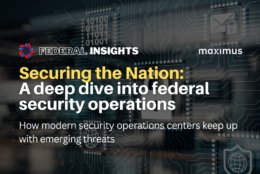Artificial Intelligence
-
Artificial intelligence is the type of software that is finding its way into every domain. But AI also depends on specialized semiconductor circuits. One warning suggests that these chips, and the systems that use them, need protection from theft and misuse.
February 13, 2024 -
With ChatGPT dominating headlines about AI, agencies are interested in what generative AI can do for them. But often, it’s a solution in search of a problem.
February 13, 2024 -
Agencies can implement AI across multiple uses cases by adopting standard governance and tools, advises the IBM AI and technology leader.
February 12, 2024 -
Barry Leffew, the vice president of the government platform accelerator at In-Q-Tel, said areas like cybersecurity, enterprise technology, space, lightweight energy sources and biotechnology are among the company’s top investment focus areas.
February 12, 2024 -
The TMF is looking to invest in projects that will accelerate the rollout of artificial intelligence tools across the federal government.
February 08, 2024 -
Trey Hodgkins, a long-time federal procurement expert and now senior vice president at Phoenix Strategies, a government affairs firm, delves into what the recent artificial intelligence executive order means for federal contractors.
February 07, 2024 -
The recent National Defense Industrial Strategy highlighted the erosion of U.S. industry's capacity for making things, which includes printed circuit boards (PCB) at the complex end of electronics. Now there are signs the domestic PCB industry is awakening.
February 06, 2024 -
As agencies outsource and modernize security operations center staffs, they need assurance SOC employees have both certifications and up-to-date knowledge.
February 05, 2024 -
The U.S. Government Publishing Office (GPO), once a bastion of ink, paper, heavy printing presses, and light-emitting diode or led type, is now fully in the 21st century. It is looking at ways it can improve operations with artificial intelligence. GPO Director Hugh Halpern recently testified before the Senate Rules and Administration Committee about AI.
February 05, 2024 -
Artificial intelligence use cases are so numerous, federal agencies need to move fast. But they also need to use caution, especially in the generative branch of AI
February 05, 2024 -
By all accounts, artificial intelligence is changing how organizations must approach cybersecurity. Not everyone is quite certain how. Now, a really big working group assembled by the Aspen Institute has come up with specific recommendations on dealing with AI in the cybersecurity context.
February 02, 2024 -
The DoD CIO wrote a Risk Management Framework overlay for securing the overarching AI environment. It’s “vague about what to look for and how to do the security, but it’s a start,” said DoD CIO David McKeown.
February 01, 2024 -
It's the oldest challenge in government and business: How to make things easier for customers. In the digital age, customer service has evolved into something more ambitious: customer experience (CX). CX asks, among other things, how you get the idea of better service or experience down to the individual employee.
February 01, 2024 -
Nakasone says one of the major challenges that needs addressing is how quickly military forces rotate in and out of CYBERCOM.
January 31, 2024 -
How do AI, cloud computing and analytics fit into creating a successful zero trust strategy?
January 30, 2024
















